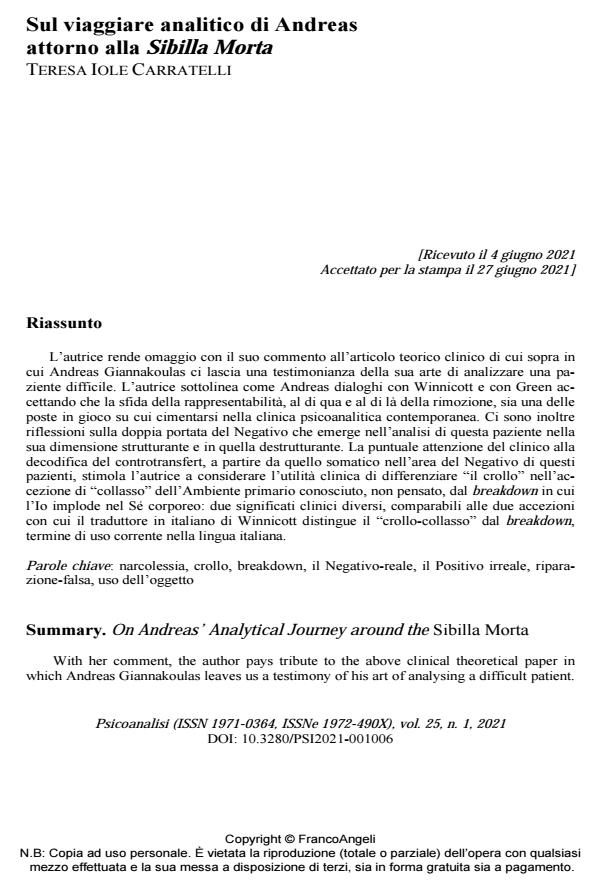On Andreas’ Analytical Journey around the Sibilla Morta
Journal title PSICOANALISI
Author/s Teresa Iole Carratelli
Publishing Year 2021 Issue 2021/1 Language Italian
Pages 12 P. 87-98 File size 156 KB
DOI 10.3280/PSI2021-001006
DOI is like a bar code for intellectual property: to have more infomation
click here
Below, you can see the article first page
If you want to buy this article in PDF format, you can do it, following the instructions to buy download credits

FrancoAngeli is member of Publishers International Linking Association, Inc (PILA), a not-for-profit association which run the CrossRef service enabling links to and from online scholarly content.
With her comment, the author pays tribute to the above clinical theoretical paper in which Andreas Giannakoulas leaves us a testimony of his art of analysing a difficult patient. The au-thor emphasizes how Andreas dialogues with Winnicott and Green, accepting that the challenge of representability, on both sides of the repression, is one of the issues at stake when engaging in the contemporary psychoanalytic clinic. There are also reflections on the double significance of the Negative - in its structuring and de-structuring dimensions - that emerges in the analysis of this patient. The clinician's careful attention to decoding the countertransference, starting from the somatic one in the Ne-gative area of these patients, stimulates the author to consider the clinical usefulness of diffe-rentiating between two meanings of collapse - one in the sense of collapse of the primary en-vironment - known not thought, and the other as a breakdown in which the ego implodes into the bodily self: two different clinical meanings, comparable to the two meanings with which Winnicott’s translator into Italian distinguishes the "collapse-collapse" from the breakdown term in current use in the Italian language.
Keywords: Narcolepsy, collapse, breakdown, the real-Negative, the unreal Positive, false rep-aration, use of the object
- Baldassarro A. (2018). La passione del negativo: André Green e la psicoanalisi contemporanea. In: La passione del Negativo Omaggio al pensiero di André Green. Milano: Franco Angeli.
- Carratelli T.I., Bonaminio V., Giannotti A. (1989). Riflessioni sul trauma silente. Psichiatria dell’Infanzia e dell’Adolescenza, 56, 5: 535-538.
- Fabozzi P. (2016). Fenomeni e processi distruttivi nell’opera di D.W. Winnicott. Psiche, 1, 313: 67-87. DOI: 10.7388/83165
- Giannakoulas A. (1998). L’interpretazione e le sue vicissitudini. La tecnica in questione. In: Algini M. L. (a cura di). Tra ascolto e interpretazione. Roma: Borla, 2000.
- Giannakoulas A. (2007). La tradizione indipendente e l’essere indipendenti. In: Andreas Giannakoulas. La tradizione psicoanalitica britannica. Roma: Borla, 2010.
- Giannakoulas A. (2007). Continuità dell’essere, vivere, sperimentare D.W. Winnicott, W. Bion, M. Milner, M. Khan. In: Andreas Giannakoulas. La tradizione psicoanalitica britannica. Roma: Borla, 2010.
- Giannakoulas A. (2007). La Sibilla morta. Riparazione e restituzione di un’assenza. In: Andreas Giannakoulas. La tradizione psicoanalitica britannica. Roma: Borla, 2010.
- Green A. (1980). La madre morta. In: Narcisismo di vita, narcisismo di morte. Milano: Raffaello Cortina, 2005.
- Green A. (1996) Il lavoro del Negativo. Roma: Borla.
- Green A. (1997). L’intuizione del Negativo in “Gioco e Realtà”. In: Abram J. (a cura di). Giocando con Winnicott. Il dialogo a distanza tra Green e Winnicott. Milano: Franco Angeli, 2020.
- Green A. (2010). Origini e vicissitudini dell’essere nell’opera di Winnicott. Richard & Piggle, 25, 3: 219-237. DOI: 10.1711/2733.27857
- Hernandez M., Giannakoulas A. (2003). Sulla costruzione dello spazio potenziale. In: Bertolini M., Giannakoulas A., Hernandez M. (a cura di). La tradizione winnicottiana. Roma: Borla.
- Laufer M. (1986). Adolescenza e breakdown evolutivo. Torino: Boringhieri.
- Milner M. (1987). L’alba dell’eternità. Roma: Borla, 1990.
- Winnicott D.W. (1948). La riparazione in funzione della difesa materna organizzata contro la depressione. In: Dalla Pediatria alla Psicoanalisi. Scritti scelti. Firenze: Martinelli, 1975.
- Winnicott D.W. (1952). L’angoscia associata all’insicurezza. In: Dalla Pediatria alla Psicoanalisi. Scritti scelti. Firenze: Martinelli, 1975.
- Winnicott D.W. (1963). La paura del crollo. In: Esplorazioni psicoanalitiche. Milano: Raffaello Cortina, 1995.
- Winnicott D.W. (1965). Sviluppo affettivo e ambiente. Roma: Armando, 1970.
- Winnicott D.W. (1968). L’uso di un oggetto e l’entrare in rapporto attraverso le identificazioni. In: Esplorazioni psicoanalitiche. Milano: Cortina, 1995.
- Winnicott D.W. (1953, 1969, 1971). Oggetti e fenomeni transizionali. In: Gioco e Realtà. Roma: Armando, 1974.
- Il trauma e le sue vicissitudini nel lavoro clinico Annita Gallina, in PSICOANALISI 1/2022 pp.73
DOI: 10.3280/PSI2022-001006
Teresa Iole Carratelli, Sul viaggiare analitico di Andreas attorno alla Sibilla Morta in "PSICOANALISI" 1/2021, pp 87-98, DOI: 10.3280/PSI2021-001006